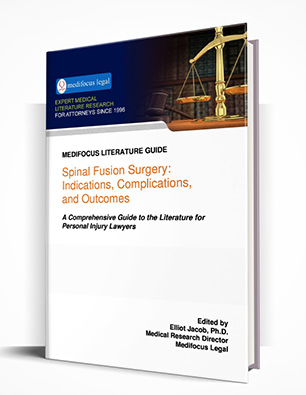Spinal Fusion Surgery: Indications, Complications, and OutcomesA Comprehensive Guide to the Literature for Personal Injury Lawyers
Publisher: Medifocus Legal
Publication Date: August 22, 2016
Number of Pages: 256
A Comprehensive Guide to the Literature for Personal Injury Lawyers
Publisher: Medifocus LegalPublication Date: August 22, 2016
Number of Pages: 256
There are many surgical approaches and methods available for spinal fusion surgery. The spine may be approached and the bone graft placed either from the back (posterior approach), from the front (anterior approach), or by a combination of both techniques. The ultimate goal of fusion is to achieve a solid union of two or more vertebrae. Recovery following fusion is generally longer than for other types of spinal surgery. It also takes longer to resume normal activities and return to work after spinal fusion than for other types of back surgery because the time to achieve fusion varies among individuals as the body heals and incorporates the bone graft to fuse the vertebrae together.
Spinal fusion surgery is used to treat many back conditions including spinal stenosis, degenerative disc disease, spinal fractures, spondylolisthesis, scoliosis, and spinal tumors. Outcomes of spinal fusion surgery are influenced by a variety of factors including patient selection, surgeon experience, surgical approach and techique, and preexisting patient factors such as smoking or diabetes. As with any type of major surgery, spinal fusion surgery carries the risk of complications, some of which can be serious or even life-threatening. Complications may include deep venous thrombosis, pulmonary embolism, vascular injuries, deep wound infection, breakage of the metal screws used for internal fixation, unsuccessful fusion of the vertebrae (pseudoarthrosis), and persistent, chronic pain after surgery (failed back surgery syndrome).
Spinal Fusion Surgery: Techniques, Indications, Complications, and Outcomes is a comprehensive reference guide to the medical literature for personal injury attorneys who may be involved in litigating spinal fusion cases. This unique Guide consists of over 260 hand-selected references published in peer-reviewed journals with links to the article abstracts and full-text sources. You also receive FREE online access to full-text copies of 36 journal articles - an estimated value of about $1,100 based on the average cost of the individual articles. The articles referenced in the Guide focus on the techniques, indications, complications, and outcomes of spinal fusion as published in the medical literature over the past decade.
 |
- A comprehensive bibliography of 268 journal article references indexed in MEDLINE published in well respected medical and scientific journals.
- Online access to the abstracts (summaries) of the articles.
- Online access to the free full-text version of 36 articles.
- Links to full-text sources of other articles that are available for purchase directly from individual journal publishers.
- A unique "Author Directory" consisting of the names and institutional affiliations of experts who have published and have specialized knowledge about Spinal Fusion Surgery: Indications, Complications, and Outcomes. The "Author Directory" is a valuable resource for quickly identifying and locating experts for case reviews, opinions, and testimony.
Select examples of topics that are covered by the articles referenced in this Guidebook include:
- Risk factors for deep venous thrombosis in patients undergoing lumbar interbody fusion.
- Anterior lumbar spine surgery: A meta-analysis of associated complications.
- Visceral, vascular, and wound complications following over 13,000 lateral interbody fusions.
- Guideline update for the performance of lumbar fusion for intractable low-back pain without stenosis.
- Outcomes after laminectomy and fusion in patients with cervical myelopathy.
- Incidence and risk factors for deep vein thrombosis and pulmonary embolism after spine surgery.
- Injury to major abdominal vessels during posterior lumbar interbody fusion.
- Instrumentation related complications in spine surgery.
- Complications associated with posterior and transforaminal lumbar interbody fusion.
- Complication avoidance and management in anterior lumbar interbody fusion.
- Vascular injury in elective anterior lumbosacral surgery.
- Indications for surgical fusion of the cervical and lumbar motion segment.
- Stabilization surgery for chronic low back pain: indications, surgical procedures, and outcome.
- Posterior lumbar interbody fusion: indications, techniques, and results.
- Adjacent segment disease in the lumbar spine following different treatment interventions.
- Nerve injury after lateral lumbar interbody fusion.
- Major neurological deficit following anterior cervical decompression and fusion.
is available in two formats: | |
Order by Phone:To order by phone, please call: Order by Mail:To order by mail, please print and complete this Order Form | |

